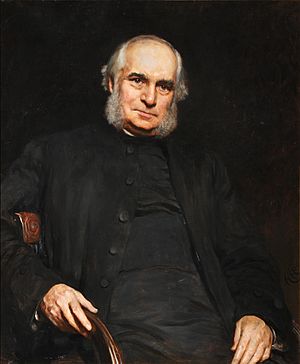William Stubbs facts for kids
Quick facts for kids The Right Reverend William Stubbs |
|
|---|---|
| Bishop of Oxford | |

Portrait by Hubert von Herkomer, 1885
|
|
| Diocese | Oxford |
| In Office | 1889 to 1901 |
| Predecessor | John Mackarness |
| Successor | Francis Paget |
| Other posts | Regius Professor of Modern History (1866–1884) Bishop of Chester (1884–1889) |
| Orders | |
| Consecration | 25 April 1884 |
| Personal details | |
| Born | 21 June 1825 Knaresborough, England |
| Died | 22 April 1901 (aged 75) Cuddesdon, England |
| Buried | All Saints, Cuddesdon, Oxfordshire |
| Nationality | British |
| Denomination | Anglican |
| Spouse | Catherine Dellar |
| Education | Ripon Grammar School |
| Alma mater | Christ Church, Oxford |
William Stubbs (born 21 June 1825, died 22 April 1901) was an important English historian and a bishop in the Anglican Church. He was a professor of history at the University of Oxford for many years. Later, he became a bishop, first in Chester and then in Oxford.
Contents
Early Life and Education
William Stubbs was born in Knaresborough, Yorkshire, England. His father, William Morley Stubbs, was a lawyer. William went to Ripon Grammar School and then studied at Christ Church, Oxford. He did very well in his studies, especially in ancient literature and history.
Becoming a Historian and Professor
After finishing his studies, Stubbs became a Fellow at Trinity College. He also worked as a parish priest in Navestock, Essex, from 1850 to 1866. In 1859, he married Catherine Dellar, and they had several children.
In 1866, William Stubbs became the Regius Professor of Modern History at Oxford. This was a very important teaching position. He taught history at the university until 1884. He also helped create Oxford University's School of Modern History in 1872. This allowed history after ancient times to be taught as its own subject.
Life as a Bishop
William Stubbs was appointed a canon of St Paul's Cathedral in 1879. A canon is a type of priest who works at a cathedral. On 25 April 1884, he became the Bishop of Chester. A bishop is a senior leader in the Christian church.
In 1889, he became the Bishop of Oxford, a role he held until his death. As the Bishop of Oxford, he also had a special role as the Chancellor of the Order of the Garter. This is a very old and important order of knighthood in Britain.
Stubbs was known for his strong beliefs as a High Churchman. This means he followed traditional practices and beliefs within the Anglican Church. His ideas were respected by other bishops.
Later Years and Passing
In November 1900, William Stubbs became ill. Even so, he was able to attend the funeral of Queen Victoria in February 1901. He even gave a sermon to King Edward VII and the German Emperor Wilhelm II.
His health worsened, and he passed away on 22 April 1901 in Cuddesdon, England. He was buried in the churchyard of All Saints, Cuddesdon, near the palace where the bishops of Oxford lived.
Awards and Recognition
William Stubbs was highly respected as a historian in England and around the world. He received many special awards and degrees. He earned honorary degrees from famous universities like Oxford, Cambridge, and Edinburgh. He was also an honorary member of important academies in Prussia, Bavaria, and Denmark. He even received the Prussian award Pour le Mérite. In 1897, he became a member of the American Antiquarian Society.


